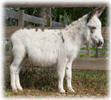TRAINING MINIATURE DONKEYS
Train Your Miniature Donkey
ForSale:
Check Our Availability
 Check
out our For Sale Page.
Check
out our For Sale Page.
We have Jennies, Jacks and Yearlings Available.
HerdSires
Meet Flash!
Meet Our Newest Spotted Jack
 Flash
is one of our new spotted Jacks. Come Meet Flash! ....continue
Flash
is one of our new spotted Jacks. Come Meet Flash! ....continue
Training
How Do I Do That?
They're So Cute
 We believe Miniature Donkeys were bred to be, and should remain, athletic and capable animals. In our breeding program we select for donkeys with the big stride, grace, and balance that are desirable in a top performance animal.
...continue
We believe Miniature Donkeys were bred to be, and should remain, athletic and capable animals. In our breeding program we select for donkeys with the big stride, grace, and balance that are desirable in a top performance animal.
...continue
Training Miniature Donkeys
Now What Do I Do?
We believe Miniature Donkeys were bred to be, and should remain, athletic and capable animals. In our breeding program we select for donkeys with the big stride, grace, and balance that are desirable in a top performance animal.
We look for donkeys with a deep hip and level top line. We also believe donkeys should have a beautiful eye and expression.
Miniature donkeys are wonderful friends and companions. Children can be given great freedom with them because they seldom bit or kick and they crave attention. Even small children can be successful handling a friendly donkey and that can really foster self confidence and teach the benefits of nurturing. They are also a great companion to the elderly or those who for various reasons are not able to interact the way they used to with their horses.
Miniature Donkeys are very rewarding to train because of their quick intelligence, inquisitive nature, and eagerness to please. Despite their small stature, Miniature Donkeys have the ability to pack fifty to eighty pounds. They are wonderful trail companions and can enrich any hiking or backpacking experience. They are people magnets so be prepared to be popular. Miniature Donkeys can readily be taught to pull carts and can be driven successfully by almost anyone. The necessary equipment for driving is readily available and inexpensive. Miniature Donkeys can be shown competitively in many classes including trail, speed events and obstacle driving in the cart. Most donkey owners/breeders are an inclusive group and are happy to lend a hand if asked so there is no need to be shy if you are new to all this.
Miniature Donkeys also offer a great way to give back to your community by sharing them with science fairs, classrooms, nursing homes, Christmas and Easter celebrations, and many, many more situations. Let creativity be your guide! I have found that sometimes it is preferable to beg for forgiveness rather than ask for permission. Occasionally the folks in charge worry about the safety of being around an equine but when they find out how donkeys differ from horses they become comfortable with the idea. I have never been asked to leave and have never had anyone hurt or have a bad experience. These little guys will let you dress them up in foolish costumes and go just about anywhere for you! Sometimes in a busy life making the time for these experiences is challenging but at the end of the day I have always felt that these outings were memories I would cherish.
Steps in Training Your Donkey
Instructions
- Familiarize the donkey with your and his environment. It is necessary to establish a trust with the donkey to get him to cooperate. Be friendly and consistent in your temperament, approach, body language and tone.
- Use your voice as the first tool of training and start with small commands for following you, backing up, slowing down and lifting her feet for the farrier to inspect. Make your commands clear and consistent. Donkeys are slow learners and they can get confused and startled by anything new. Repetition is the key.
- Combine the voice commands with treats like carrots or apples during the initial training phase. Use them only as rewards and not as a bribe. Gradually change the rewards to verbal praises and pats.
- Introduce the halter to the donkey by rubbing his back with it and holding it near his face while giving treats. This familiarizes the donkey with the position in which the halter is fastened. Slide the noseband on and praise him for his cooperation. Take off the halter and repeat it until he is accustomed to it.
- Lead the donkey by pulling the rope gently with voice commands. If she does not move, pull her on her side in a circle, so she takes a step to maintain her balance.
- Train the donkey to lift his legs for hoof inspection by getting him comfortable with grooming. Use your hands and a soft broom to stroke down the legs all the way to the knee. With gentle praises, lift his leg without enclosing his ankle in your hand and put it back down.

